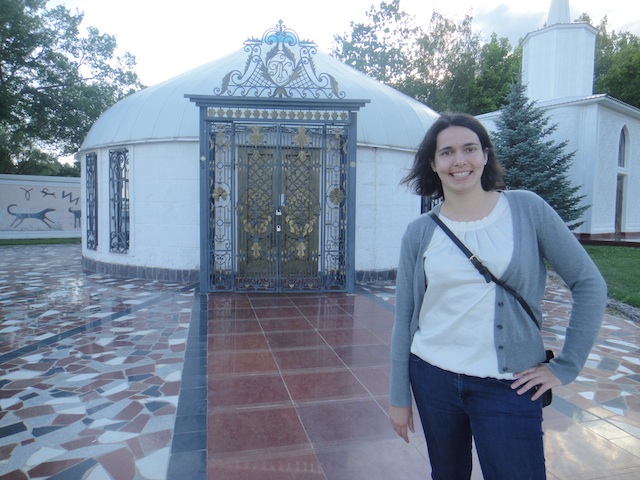Vacation at Issyk-Kul
For my last weekend in Kyrgyzstan, I left the city and went to Issyk-Kul (hot lake). The lake is the second largest mountain lake in the world and the second largest saltwater lake in the world. It is only slightly saline and, though it is high in the mountains (1 mile high) and is surrounded by snow in the winter, it never freezes. It is 113 miles long. We could see each end from the center, but not well. According to wikipedia, historians believe it is the point of origin for the Black Death. More facts about the lake: http://en.wikipedia.org/wiki/Issyk_Kul
I went with an intern (Aigul) and two of her friends, all local college students. We slept in a hotel owned by one of Aigul's friends. We stayed at the beach most of the time, but over the course of three days we went to a museum, rode a ferry, rode a ferris wheel, went to a banya, and I went parasailing. It was an incredible weekend. The town we stayed in is called Bosteri. It neighbors Cholpon Ata, the main tourist city. The beaches are very close to each other, so we were able to take advantage of the food and activities in the main town and the calmer beaches in Bosteri.
Cholpon Ata was a popular tourist destination during Soviet times, but lost much of its business after the collapse of the USSR. It is now very popular for Kyrgyz nationals and other tourists from Central Asia. There are only a handful of high-end resorts and hotels. Most places to stay are small bed and breakfast establishments. There is a lot of construction near the beach and around the main road, but much of what I saw was in various stages of completion and no one was working on it. It's a shame the area is not more developed because the lake is absolutely beautiful and would be a much larger boon to the economy if foreign tourists came. Only a small part of the lake is popular now, but I imagine more beach towns will pop up in the coming years.
The beach was crowded, but it had a small town feel that I've never encountered before. Children, men, and women walked around selling smoked fish, samsa, fruit, cotton candy, corn-on-the-cob, henna tattoos, and pictures with camels. In the more popular areas, there are about 100 booths selling food, drinks, adventure packages, and souvenirs. There were bars in tents blasting American music. Every 200 yards or so is a landing spot for parasailers. There are a couple swimming areas, but people tended to swim in front of their umbrellas, regardless of the lack of designated area. There were jet-skis and paddle boats for rent. Large passenger boats left the two docks every 45 minutes for the center of the lake. It was an ideal place for just sitting on the beach, but it was easy to find things to do when we wanted to be active.
The museum, Ruh Ordo was surprisingly nice. The entrance fee of $7 is steep for Kyrgyzstan, but it was worth it. I couldn't take a tour because they only offered them in Russian, but many of the signs were in English. It's an outdoor museum on the water honoring a famous Kyrygz author, Chyngyz Aitmatov. There is a building for meetings and small buildings representing religions of the world (a mosque, a synagogue, a church, and an Orthodox church). The museum hosts political meetings occasionally, which explains its high quality. Rather than showcasing the history of Kyrgyzstan, there were statues representing themes from all over the world such as Greek philosophy and mythology, Asian poetry, French religious history, and Kyrgyz war heroes. There was no discernible theme, though the tour guides probably explained the variety somehow. Some or all of the statues and artifacts are gifts, so perhaps the museum simply takes whatever is offered.
It was great to get out of the city and enjoy the cool water for a weekend. Only one week left and I am glad I spent some of my final days in such a beautiful place.
Here are some pictures of the lake and the museum:

